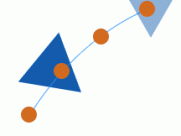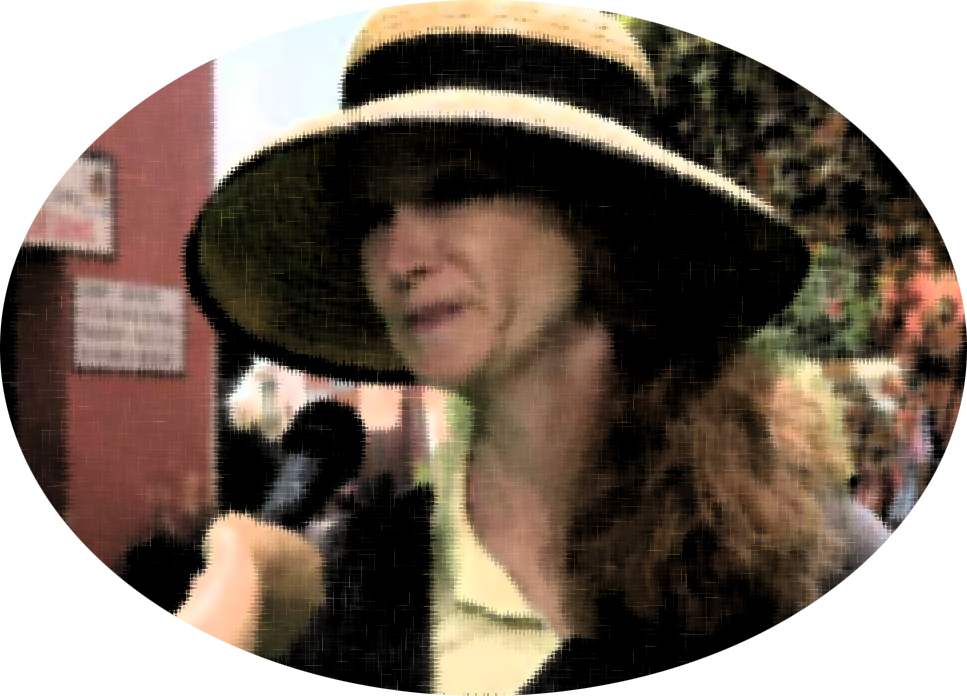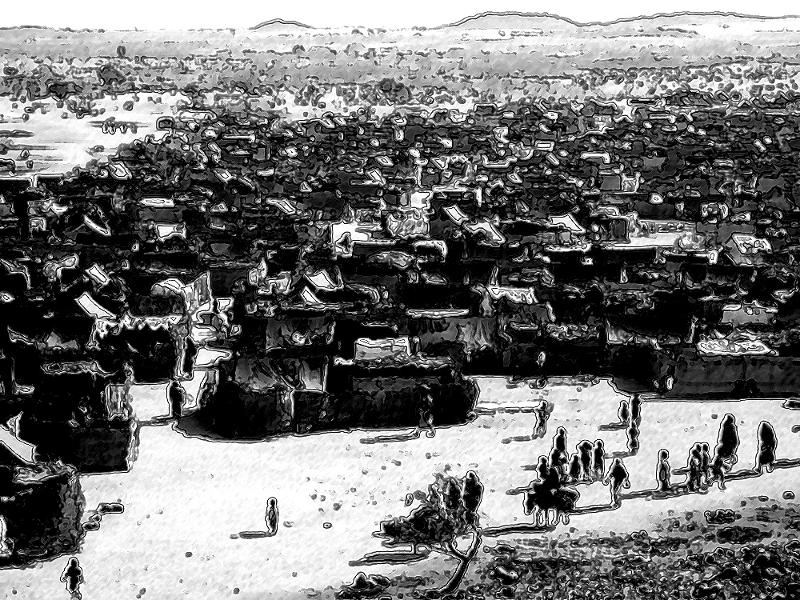

Nina Novus Scriptor is scanning Twitter, then the Web, for any news of Dr. "Dyna" Mundi. There was one Tweet recently congratulating her on a successful global health event promoting prenatal care, but there has been nothing that might indicate her location. Scriptor opens up her digital file to add some more information about her target.
Dr. Salus "Dynamica" Mundi speaks English, French, Spanish, and snippets of other world languages. She maintains a full raft of inoculations to enable her travels to most parts of the world. She packs her own vitamins to keep up her health when she travels. She apparently maintains several homes on different continents.
Then a snippet of news from the airport. A woman who has been verified as Dr. Mundi has been seen at the local airport. A scan of her bags showed that she packed comfortable shoes including some airy sandals. Her clothing appears light and easy to hand-wash. She has a small bag of various over-the-counter medications—anti-diarrheal pills, mosquito repellant, sunscreen, and a small first aid kit.
Then another Tweet: " "Gani, Dr. M—in the n. hemisphere, working on camp design!" Then another colleague posts an image. The image looks to be an image of many tents scattered along flat ground. The photographic image seems to have been captured with a camera without automated global positioning system (GPS) metadata coordinates captured.

(The above image is an open-source image about a refugee camp. The image was modified to make it somewhat less recognizable.)
Her editor is still interested in the story but cautions her: "The budget on this story is starting to dwindle. Make sure you get the scoop!"
|
A BLOG POST Understanding Refugee Camps and their DynamicsBy Dr. Salus "Dynamica" Mundi A refugee camp is generally defined as: "shelter for persons displaced by war or political oppression or for religious beliefs," (Princeton: http://wordnetweb.princeton.edu/perl/webwn?s=refugee%20camp ). Yet there is much more to fully understanding what makes up a refugee camp and its way of life. Structure and Organization Most refugee camps are built on the edges of towns or cities, always from risky areas like borders, war zones, or areas with known land mines. These are built near water sources, so that the people can access the necessary water for cooking, drinking, bathing, and clothes washing. The logistics of such refugee camps require access to modes of transportation to receive the various supplies necessary for running such camps.
The residents nearby are often leery of those in the temporary camps because they fear that these newcomers will destabilize the local areas and compete with them for food or water. This is why it is often important to have local government support for such camps in order to enable them to function.
A photo posted of the camp shows acres of canvas tents set up across the dusty and flat ground; some of the housing is make-shift, with any sort of scrounged blankets and tarps used as coverings against the elements. Families crowd around water boiling in pots. Many of the refugees move slowly around the camp. Many look dazed. There is some semblance of order. Some parts of the camp seem more orderly than others. The refugees had already started gathering before international aid organizations arrived to help, so some pre-existing sections seem like a mish-mash of humanity. A field hospital handles those who are in need of acute medical care.
Medical Issues Those who are seen to have potential diseases are separated out from the others—in a kind of quarantine—to mitigate the risks to others' health. The camp, even though it's been surrounded with fencing or barbed wire to keep out marauders, cannot control for the animals that wander through the camp. There are some of the burrows that were used to bring some of the families to the camp. There are also some stray dogs. Animals may carry zoonotic diseases that affect human health, so the camp physicians pay attention to symptoms of ill health in the animals that may be indicative of possible zoonotic diseases.
Water-borne illnesses are a health risk. Most water sources provide water that is not potable, so it has to be boiled thoroughly or treated with chemicals to eliminate dangerous bacteria, viruses, and other pathogens. Latrines are placed downstream from water sources—so that human waste will not lead to various illnesses like various parasitic infections and diseases ( http://en.wikipedia.org/wiki/Waterborne_diseases ). Refugee camps have used various methods of providing spaces for the collection of human waste—such as collective trench latrines, pit latrines, and defecation fields.
Hygiene is difficult to maintain in the refugee camps. The only laundry services are by hand-washing, and there is not any organized system for that except at the make-shift hospital. Refugee camp workers have to maintain their own physical, mental, and emotional health and stamina in order to best serve those around them. However, they also need breaks from the crowds in order to build up the strength for themselves. Published sources define the basic provisions needed for each person: a gallon of water a day, and a daily food ration of 2,261 calories daily. The provisions may consist of rice, wheat, or maize (400 gpp = grams per person); beans, peas, or lentils (60 gpp); vegetable oil or butter oil (25 gpp); fortified blended food such as a corn soya blend (100 gpp); sugar (15 gpp); and salt (5 gpp)—for a total protein intake of 71.2 grams and total fat of 47.9 grams. It is important to get the food to women usually because they tend to disseminate the provisions to the vulnerable members of the community—the elderly and the children. Sometimes, men who receive the provisions will try to sell the items for other uses. There are areas for feeding the starving, with specialized foods designed for those of various ages and for the easiest assimilation into the human body. All the workers at the refugee camps will be working 12 - 15 hour days.
Politics and Administration Everyone who is in the camp is registered and photographed, in order to maintain some semblance of order. This information will be important also to maintain health records of the camp residents. Such records may indicate particular health needs, which need to be addressed in a timely and effective way. Refugee camps also maintain records of death rates and the causes of death. Common causes of death include measles, diarrhea, acute respiratory infections, malnutrition, and malaria (Anatomy of a refugee camp http://www.cbc.ca/news/background/refugeecamp/) .
This information will be used to enforce the rules of the camp. Peacekeeping forces (or in-country military or police) police the outer rim of the camp; internally, those running the camps use the local police of the host countries within (for those with working governments)—particularly in the larger camps. Good lighting is critical to promote security for the residents of a refugee camp. Those in areas without a functioning government have to bring in international peacekeepers for this work, which further complicates the challenges of running such a camp. Further, this information will be used later to help individuals re-settle. Further, they are inoculated against common diseases—because the crowded conditions enable the mass spread of contagious diseases. The children play a simple game of soccer. The global public health workers do not know how long this camp will be in operation. There is no way to predict how the political wrangling among armed groups will take, and the effects of a drought can be long-term. While refugee camps are meant to be temporary, some have lasted for years (with some topping 50 years in existence). The weather in June in this country is fairly hospital to tent living, but as the weather evolves and turns colder, the camp will have to bring in blankets, warmer clothing, and heat sources.
Most camps also have spaces for group meetings to help the residents self-organize and to empower themselves with activities and endeavors that improve the lives of the residents.
The infrastructure of a country will take years to build or re-build. The government itself has been asking for international aid for more resilient and diversified food crops and help with setting up irrigation systems; they also have asked for international volunteers to train their country's farmers. The international health workers that run the refugee camps learn from every interaction—in order to better address the moves of masses of humanity and their needs—in the inevitable natural and human-made disasters that seem to afflict people. They know the importance of trying to create resilience in all societies against such exigencies. They also know the importance of maintaining strong political relationships with the leaders of various countries. They also work hard to stay neutral in the face of politics, to minimize risks to the health workers who deploy to many areas of the world. The workers strive to fit within the cultural expectations of the locals, so as not to give offense.
|
Nina Novus makes a video update.
It is now June. The latest sighting of Dr. Salus "Dynamica" Mundi has been at a refugee camp ( http://en.wikipedia.org/wiki/Refugee_camp ), the staging area for the sustaining of human lives in turmoil. Nina arrives at the airport and scans the monitors. She knows that Dr. Mundi arrives no more than an hour prior to her flight. She has a list of preferred airlines, on which she is racking up mileage for free flights. Ticking off the list, Nina has five choices of destinations. All five locations have displaced persons who could be at refugee camps. If she wants any chance of catching up to her, she has to get on the next flight out. She has her colleagues paying close attention to the various information feeds and a Google Alert on Dr. Mundi's name. If her paper is going to get the world exclusive on Dr. Mundi, she's going to need all the help she can get.
She grabs her trusty suitcase with the easy-wash clothing. She packs granola bars, tuna, and water. She has her international press pass. She brings her backpack with the necessary technologies--her spendy satellite telephone, a digital camera, and her tablet PC.
She peruses a map of the world.

Directions: Play only one of the following videos to the location that you've identified.
Ecuador
Japan
Kenya
Canada
Ethiopia
She applies for an emergency entry stamp for her passport and buys round-trip tickets. She packs a bag with some basics. She boards the plane. When it gets to altitude, she turns on her tablet PC and starts drafting up questions--for when she finally meets up with Dr. Mundi.
toc | return to top | previous page | next page